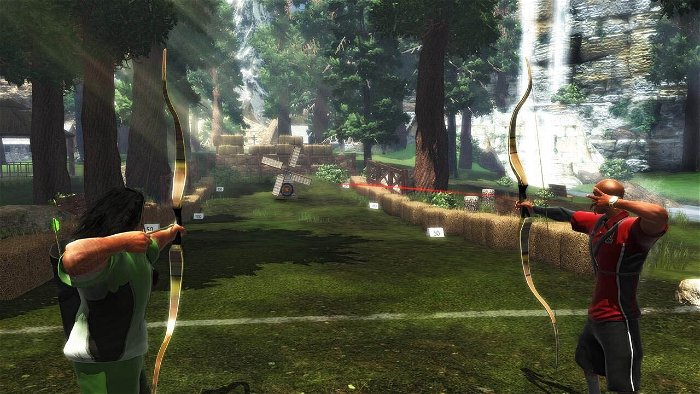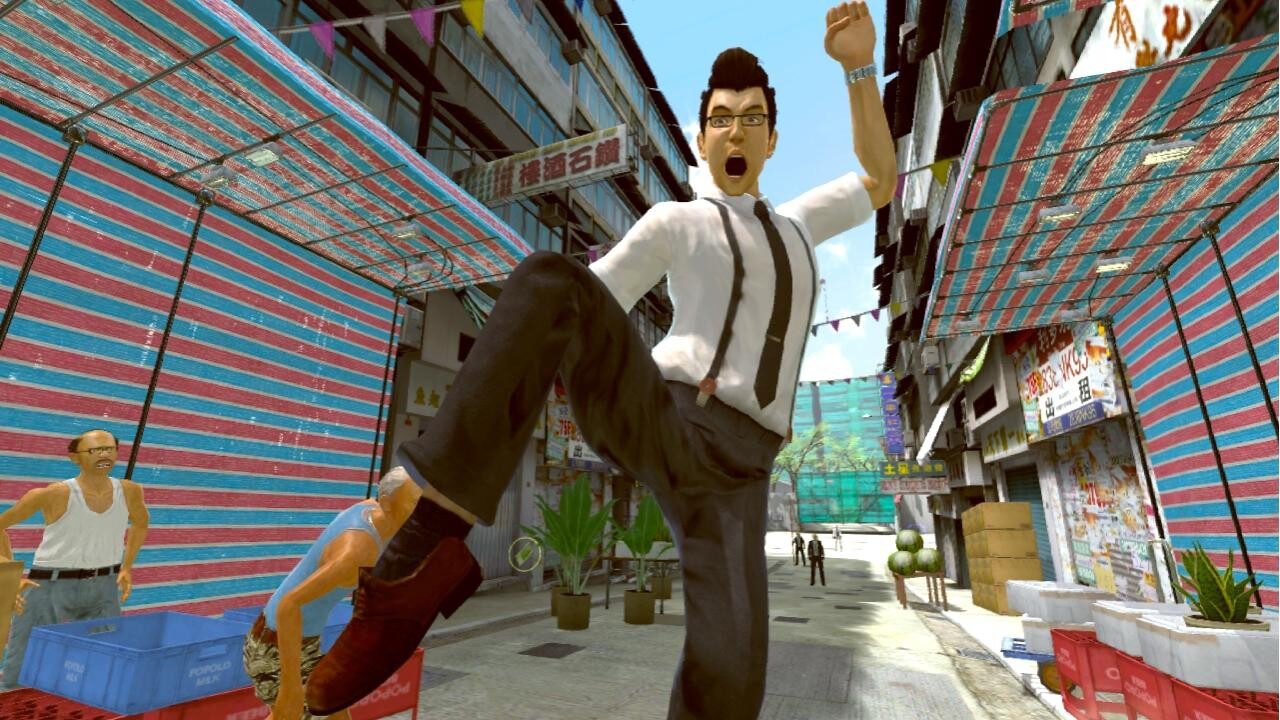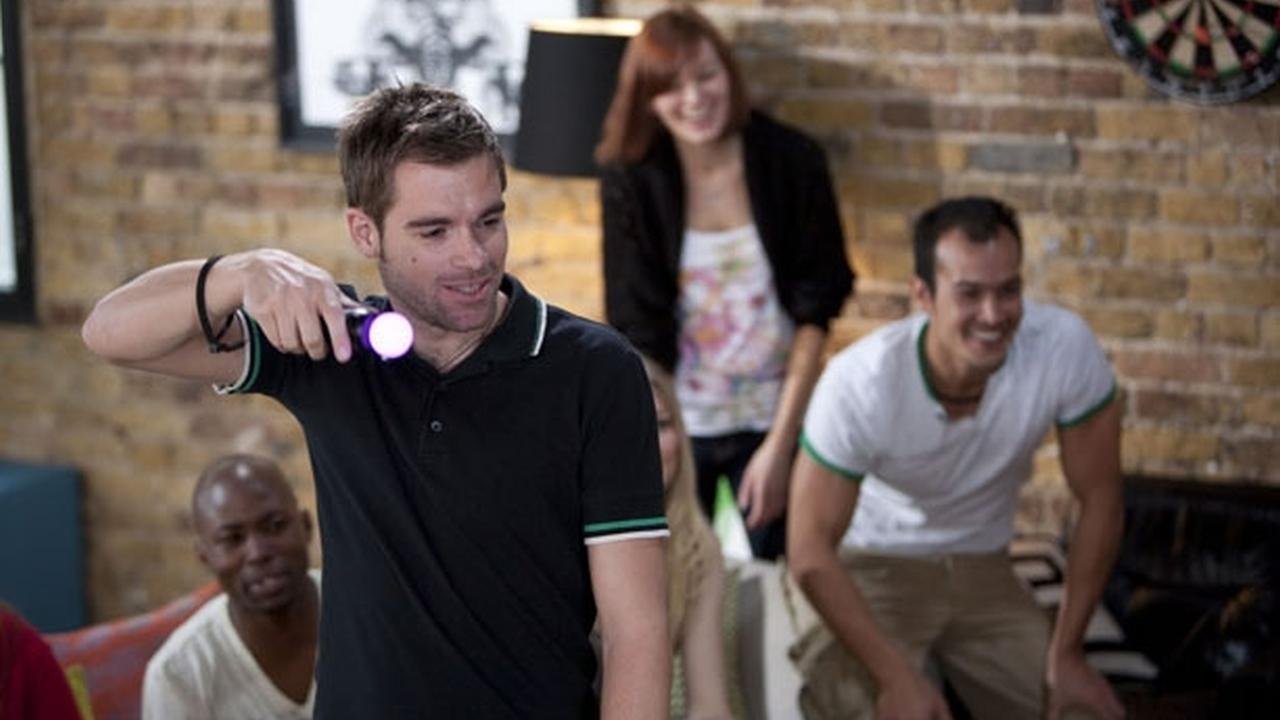2010 is going to be the year that all three gaming consoles support—in varying degrees—some kind of motion sensor functionality. We got the chance to go down to the corporate headquarters of Sony Canada to try out Move, Sony’s response to Nintendo’s Wii Motion+ and Microsoft’s Kinect systems to see how it compares. The first thing that needs to be looked at here is the fact that yes, both Sony and Microsoft are late to this particular party.
Nintendo established the beach-head in 2006 with their Wii console being fully integrated for motion control from day one, and it grabbed the casual audience in with sales numbers no one could have predicted. Since then, the Wii has gone on to establish its place in the current generation as the console for families, while the Xbox 360 has taken the lead as the defacto shooter/multi-player console, and the PS3 has become the leader in technology and experimental games. Now both Sony and Microsoft are hoping to tap into that massive audience that loves playing Wii Sports and other, more casual, family friendly fare. Sony’s tactic is to simply do what the Wii does, but better. How does it stack up?
The Facts
Move comes down to two essential pieces of technology with an option for a third. The pillar of the technology rests on the existing Playstation Eye camera, a peripheral that was released for the console in 2007, and is itself an iteration of the EyeToy camera that was released for the Playstation 2 in 2003. While the new Playstation Eye camera has received little in the way of extensive support from Sony since its release, a few novelty games and DLC applications are available that show off its augmented reality ambition for gameplay.

The next piece of the puzzle is the new Playstation Move motion controller, which is a wand-like apparatus with buttons, and a soft ball on top that can change colors thanks to RGB LEDs built into it. It’s also built with a host meters such as an accelerometer, magnetometer and rate sensor to correctly transmit data such as angle, rotation and other positional information. What this translates to in practical gaming terms is that the combination of motion control meters along with the camera picking up the light emitted from the sphere creates a wealth of positional data for impressively accurate information. The Move system always knows where the controller is, what angle its being held at, and even whether or not its being rotated.
The final addition to the Playstation Move system is one that’s strictly optional, though hardcore gamers looking to use the Move in more meaningful ways will find it a more convenient solution. Sony is also offering a Move “Navigation Controller” that looks similar to the motion controller itself. It’s shaped like a wand, but lacks the soft ball on top, and has an analog stick placed where the “Move” button on the wand is, with a digital direction pad just below that. The reason that the navigation controller was created is to supplement more traditional, hardcore titles that require the ability to move while still being able to rotate the field of view. It’s not absolutely required though, as games with this functionality will support the awkward use of an existing DualShock controller in the left hand while using the motion controller in the right. That’s hardly an ideal situation though, as issues of weight and balancing come into play, especially during prolonged use, and the navigation controller is much better suited to this task than the jury-rigged solution of using an existing controller.

The Cost
Now that the technology has been laid out, let’s take a look at the dollars required for this investment. People are going to be opting into the Move system at varying levels depending on their individual situation. There will be people getting a PS3 for the first time, and for them, there is a PS3 bundle including a basic set of the Playstation Eye and one Motion Controller, the PS3 console itself, the game Sports Champions and a Playstation Move demo disc. That’s priced at $399.99. The most common bundle, however, will likely be for existing PS3 owners, which comes with the Playstation Eye, one Move motion controller, and the Sports Champions game and Move demo disc. That sells for $99.99. For the few consumers out there that have a Playstation Eye already, there’s also the stand alone motion controller for $49.99 but this means no game, although Playstation Move games will be “budget priced” at $39.99 instead of the usual $59.99 or $69.99 for traditional, AAA hardcore titles. The various odds and ends are also available separately. The Playstation Eye camera is priced at $39.99 and on the optional side of things, the Move navigation controller is priced at $29.99.
Assuming you’re already a PS3 owner, it looks like most people will be spending that $99.99 to get the “baseline experience.” This obviously won’t do for multi-player sessions, requiring a purchase of anywhere from one to three additional controllers. Most consumers will likely want at least two motion controllers for two player games, and for certain games that benefit from the use of two motion controllers simultaneously, such as The Fight: Lights Out and certain activities in Sports Champions like archery and gladiatorial style duels with a sword/shield combination. And, as previously mentioned, using a combination of a Dualshock 3 and Move motion controller, while functional, is hardly ideal, and gaming will be more comfortable and efficient with the purchase of a navigation controller.
All of that is strictly up to the discretion of the individual consumer. It’s really just a matter of how far you want to take your experience, but with the base bundle of one controller, you’ll still get a pretty good taste of what Move offers.
The Technology
If there’s one area where gamers have absolutely nothing to fear, it’s in the quality and craftsmanship of the new Move system. It doesn’t just work, it works great. Whether you’re standing or sitting, at the suggested 5 feet away from the screen or on the far end of the room on a sofa, Move can precisely detect the position of the controller and responds quickly, precisely and accurately. The combination of LED enhanced ball, camera detection and the various gyros and accelerometers transmitting positional data all contribute to a smooth, easy experience.

One important thing to note however, is that calibration is everything. When you load a new Move game into the PS3 you will have to calibrate your controller with the Playstation Eye every time. The games need to have an approximation of your location and the dimensions of your movement relative to the Playstation Eye, but once this is correctly done, Move’s responsiveness is solid.
In some ways, the descriptions of “Wii HD” are not without merit. This is pretty much what everyone expected the Wii was going to be like when it first debuted at E3 in 2005. The difference is, when the Wii finally got into the hands of users, it was found that precise movement and 1:1 tracking—that is the ability to accurately read and mimic your movements on screen—were impossible for the Wii and that accuracy came only years later with the addition of the Wii Motion+ module to system. Move operates like this straight out of the box with an uncanny level of precision. Simple gestures such as pushing the move forward and rotating it can be accurately interpreted by the Move system and replicated on screen for actions such as the turning of a key, or, in the case of an uploading downloadable game called Tumble, a Jenga-style game, delicately stacking—and then detonating—different blocks into tower-like structures.
The controller feels durable in your hand and works well. We were using the final retail versions of the motion controller, and it has a solid—though not heavy—heft to it, and is rechargeable through either a standard USB port or a special custom docking station sold as an accessory.
The Games
Of course, all this technology is only as good as the kind of experiences you can have on it, and in this regard, Sony, for the moment, is playing it safe. The array of Move-required, launch games are of the mini/party-game variety, with titles like Sports Champions included in the bundle and others such as Start the Party and TV Superstars reinforcing this wave. Existing games such as Heavy Rain will be receiving patches to enable additional Move functionality, while other titles, such as Resident Evil 5 will require the purchase of an entirely new edition of the game in order to take advantage of the added Move interface.
We got a chance to try out a sampler of games, included on the demo disc, consisting of:
Sports Champions
Eye Pet
Start the Party
TV Superstars
Time Crisis: Razing the Storm
Tiger Woods PGA Tour 11
The Shoot
Kung Fu Rider
Tumble
Beat Sketcher
Echochrome II
Games like Time Crisis and The Shoot are light gun style games that ask no more of the player than simply using the Move controller like a mouse, pointing and shooting at whatever’s on screen. As to be expected with a proven, more simplified control mechanic such as this, the shooting is fast and accurate, and gamers will have little complain about aside from the lack of a actual gun to shoot, something that is remedied by purchasing an optional pistol housing for the Move motion controller that gives players a trigger to pull.
Sports Champions, Start the Party and TV Superstars are all in the tradition of Wii party games with a mix of different activities included in the same disc. They are divided thematically, with Sports Champions obviously being based more on real world sports activities, games such as Disc Golf and Ping Pong really showing off the 1:1 tracking of Move. Players can actually curve their throws on Disc Golf, go under or over hand and generally use their arms and body as they normally would to get expected results. The same applies to Ping Pong, where at higher difficulties levels, the exact angle of attack on your shots is read correctly by the game, allowing for all the flexibility of the traditional, real world game.

Start The Party is more of an “augmented reality” party game, in that it largely depends on the Playstation Eye. The camera is used to put an image of the user in a play field, and they must play through various mini-games such as a variant on Whack-A-Mole, swatting flies, or even using a racquet to “trampoline” falling balls into a basket on the right side of the screen. Once again, the tracking is dead on for these mini-games and all movements are accurately interpreted.
Tiger Woods PGA Tour 11 fills in the expected golfing niche, and like the other games, it shows off the versatility of the Move. Because of the accuracy of the tracking, the game can’t be cheated with weak or slow swings. Move knows how much speed you’re putting into your swing and that translates directly into the length your ball will travel. There’s still a subtle “disconnect” in terms of adjusting the angle of your club based on what you see on screen, but once the adjustment is made, it’s hard to imagine playing golf games any other way. There’s still more precision and control in the traditional control system, but it’s also far less intuitive and more complex.
Kung Fu Rider fills in the requisite “weird Japanese game,” that is quintessential to Sony’s library. In this case, Move is used in a very Wii-like sense, merely requiring waggling to steer, jump and duck a pair of employees escaping downhill, on office chairs, from the Chinese mob in Hong Kong. The actual necessity of Move is questionable in this game, but it has its own charm and unique sense of humor.

Above all however, it is the downloadable content that impresses the most. Echochrome 2 uses Move to great effect, turning your controller into a spotlight that adjusts the shadows of a blocks on screen to allow your character’s shadow to navigate mazes. It’s a unique use of the system that relies on its accuracy. The same goes for Tumble, which is, for all intents and purposes, Jenga. An enormous amount of precision is required to stack blocks with full, functioning physics, and Move is up to the task. The final game, Beat Sketcher is an art program, and but it requires a fair amount of commitment to understand the interface, and get decent results.
Sony has now set the stage for Move. The technology is solid, and the final retail model we tried out showed off both quality and reliability. Now the real issue becomes, as always, the games. The initial launch line-up of Move is very casual-centric, and while the games work fine as diversions at a party, the hardcore community is going to want more substantial, meaningful ways to use the interface. It’s up to other titles such as Dead Space 2 or No More Heroes: Heroes Paradise to show Sony’s core demographic what the system can do for them.




